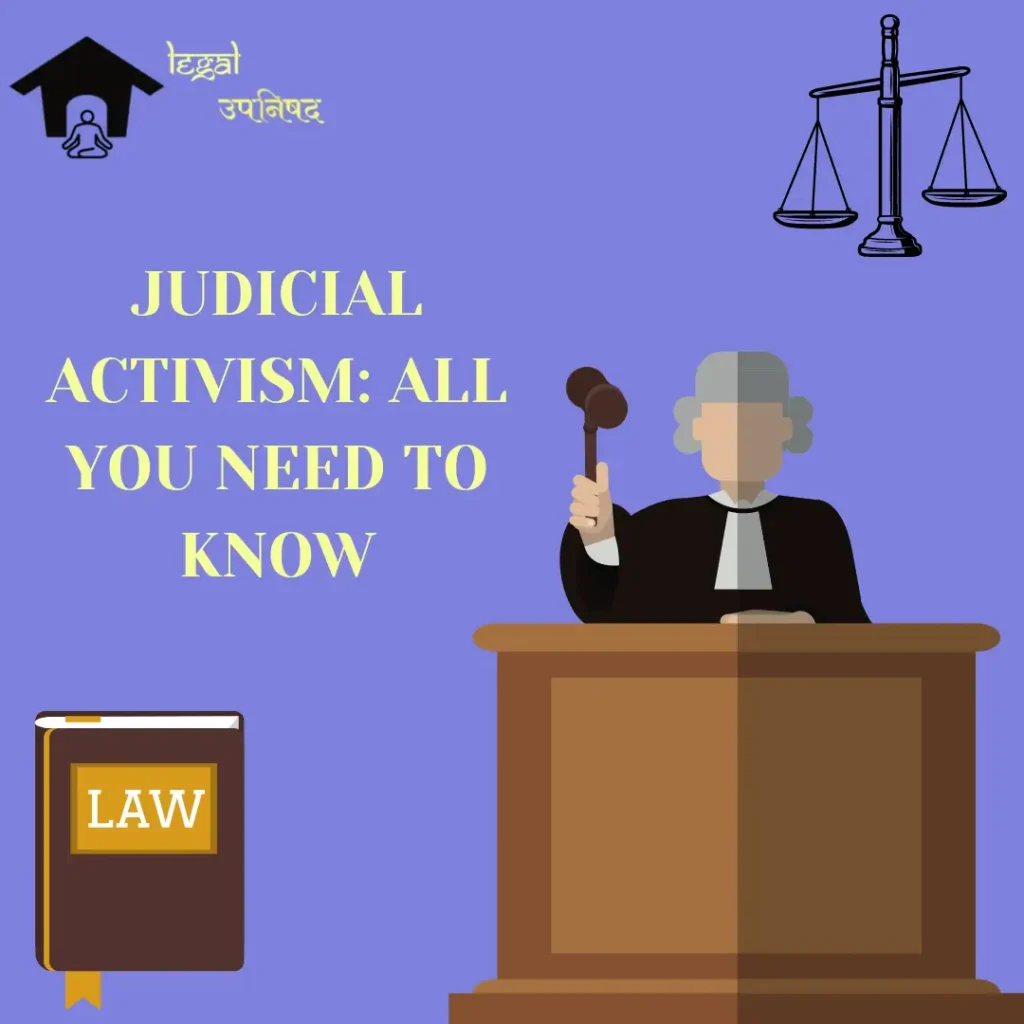This article on ‘JUDICIAL ACTIVISM‘ was written by Swaroopa Royadu, an intern at Legal Upanishad.
INTRODUCTION
Our Government has 3 organs: the Legislature, the Executive, and the Judiciary. The Legislature makes the laws, the executive implements the laws and the Judiciary interprets the laws to check those laws are not against our constitutional provisions and are not disturbing the rights of the citizens. Due to various reasons, the Judiciary has to make rulings proactively. This article covers the topic of judicial activism, its meaning, history, and methods, and also covers other aspects relating to Judicial activism.
MEANING OF JUDICIAL ACTIVISM
Judiciary is the independent organ of our government. The main function of the Judiciary is to interpret the laws and to perform the work within the framework of our constitution. The Supreme Court of India protects the fundamental rights of the citizens and protects other provisions of our constitution.
Judiciary Activism is the role played by the judiciary proactively, the decisions are based on political, personal, and socioeconomic considerations rather than on existing laws over the presiding issue with the main purpose of protecting the rights of citizens and the constitution.
Black’s Dictionary defines Judicial activism as “a philosophy of judicial decision-making whereby judges allow their personal views about public policy, among other factors, to guide their decisions”.
HISTORY OF JUDICIAL ACTIVISM
It can be said the evaluation of judicial activism marks back with judicial review. In the year 1610, chief justice Coke of Britain declared that any laws made by the parliament, which are against the principle of common laws, such laws can be reviewed and can declare void by Judiciary. In the year 1893, the concept of judicial activism can be tracked, Justice Mahmood laid the seed of Judicial activism in India.
WHY IS JUDICIAL ACTIVISM IMPLEMENTED BY THE JUDICIARY?
The main objective of the Judiciary is to provide justice to its citizens. When the judges found it difficult to provide justice by following the procedures, the judges took proactive steps to provide justice to their citizens. With the changing lifestyle and changing social needs, with the change in economic and political structure, with the development of technology the need for judicial activism has gained much more importance. For example, with the development of technology, electronic evidence is now regarded as primary evidence.
Judiciary implements Judiciary activism under the following circumstances:
- Whenever there is a violation of fundamental rights.
- When the Laws made by the legislative are ineffective mainly when they are unconstitutional.
- When the Executive fails to execute or implement the laws properly according to the provisions of the constitution.
- Whenever there is corruption, lawlessness, continuous decrease in democratic values.
- To update the laws which are already in existence to fulfill the existing needs of society.
- When the legislature and Executive themselves engage in the activity of corruption, and bias activities then the judiciary will step in.
In India, the supreme court and High court are vested with the power to declare laws as unconstitutional and void if the provisions of such laws are against the constitution. Such powers are not vested with the subordinate courts.


METHODS OF JUDICIAL ACTIVISM
- Judicial Review: The power of Judicial review vests in the supreme court and high court. Judiciary has the power to review the actions of the Legislature and Executive if the actions are contrary to the provision of the constitution. Judiciary has the power to declare such laws unconstitutional and void.
In Chandra Kumar Vs the Union of India supreme court held that the higher court judges should interpret the legislation in such a way that, the constitutional values should not be interrupted.
- Public Interest Litigation: public interest litigation is filed in a court of law to protect the interest of the public. It is the power given by the court to the citizens through judicial activism. The rule of law specifies that justice should be given to every citizen. But some sections of society cannot avail of legal support due to illiteracy, lack of knowledge, poverty, discrimination, and poor support from concerned authorities, hence to protect the fundamental rights of such sections of society public interest litigation was encouraged by the higher courts.
In People’s Union for Democratic right V/s Union of India, the Supreme court held that the old adversarial justice system is different from public interest litigation. Supreme court held that the public interest litigation is to uphold the public interest. It also held that the main purpose of public interest litigation is to bring justice to poor and economically and socially disadvantaged sections of society.
- Constitutional interpretation: constitutional interpretation comprises various methods that are available to people in attempting to solve disputes about the meaning or application of the constitution.
- International statute: To provide proper justice the higher courts refer to the judgments of the international statute.
In Jeeja Gosh V/s Union of India, “it was held that a disabled person has the right to live with dignity. In this case, the supreme court held that the Vienna Convention on treaties, 1963 requires India’s internal legislation to comply with international commitments.’’
CONCLUSION
Judicial activism has no doubt contributed to providing justice to the citizens, especially in the economically backward section, weaker section, illiterate and poor people through the introduction of public interest litigation on the other hand it should also be taken into consideration that all the organs of government are independent in their operation, over intervention may cause rise to the dispute which in turn affect the citizens. Balance is essential to carry the smooth functioning of all the 3 organs of our government.
Reference List
- Sushma Pandey. (14/11/2015) “Judicial Activism” – Retrieved: https://www.lawctopus.com/academike/judicial-activism/
- Prof. Dr Nishtha Jaswal. Dr. Lakhwinder Singh. (Jan-March,2017) “ Judicial Activism in India” – Retrieved: http://docs.manupatra.in/newsline/articles/Upload/0BD8AAF5-4031-484F-AB92-2B84EFE0ABCA.pdf
- Indian polity. (27/May/2022) “Judicial Activism, restraint, overreach” – Retrieved: https://www.drishtiias.com/to-the-points/Paper2/judicial-activism-restraint-overreach
- Judicial Review in India – retrieved: https://www.legalserviceindia.com/legal/article-746-judicial-review-in-india.html
